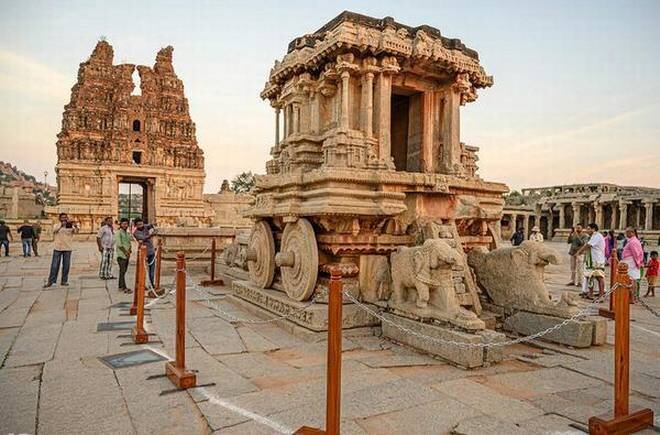Hampi Stone Chariot | 07 Dec 2020
Why in News
The Archaeological Survey of India (ASI) has taken steps to protect the stone chariot inside Vittala Temple complex at the UNESCO World Heritage site of Hampi.
- ASI, under the Ministry of Culture, is the premier organization for the archaeological research and protection of the cultural heritage of the nation.
Key Points
- Hampi Chariot:
- It is among three famous stone chariots in India, the other two being in Konark (Odisha) and Mahabalipuram (Tamil Nadu).
- It was built in the 16th century by the orders of King Krishnadevaraya, a Vijayanagara ruler.
- Vijayanagara rulers reigned from 14th to 17th century CE.
- It is a shrine dedicated to Garuda, the official vehicle of Lord Vishnu.
- Vittala Temple:
- It was built in the 15th century during the rule of Devaraya II, one of the rulers of the Vijayanagara Empire.
- It is dedicated to Vittala and is also called Vijaya Vittala Temple.
- Vittala is said to be an incarnation of Lord Vishnu.
- Dravidian style adorns the built of the complex, which is further enhanced with elaborate carvings.
- Hampi:
- It comprises mainly the remnants of the Capital City of Vijayanagara Empire. It is located in the Tungabhadra basin in central Karnataka.
- It was founded by Harihara and Bukka in 1336.
- Classified as a World Heritage Site by UNESCO (1986), it is also the “World’s Largest Open-air Museum”.
- Famous places include Krishna temple complex, Narasimha, Ganesa, Hemakuta group of temples, Achyutaraya temple complex, Vitthala temple complex, Pattabhirama temple complex, Lotus Mahal complex, etc.
- The Battle of Talikota (1565 CE) led to a massive destruction of its physical fabric.
- Battle of Talikota, confrontation in the Deccan region of southern India between the forces of the Hindu King of Vijayanagar and the four allied Muslim sultans of Bijapur, Bidar, Ahmadnagar, and Golconda.
Vijayanagara Empire
- Vijayanagara or “city of victory” was the name of both a city and an empire.
- The empire was founded in the fourteenth century (1336 AD) by Harihara and Bukka of the Sangama dynasty.
- It stretched from the river Krishna in the north to the extreme south of the peninsula.
- Vijayanagar Empire was ruled by four important dynasties and they are:
- Sangama
- Saluva
- Tuluva
- Aravidu
- Krishnadevaraya (ruled 1509-29) of the Tuluva dynasty was the most famous ruler of Vijayanagar. His rule was characterised by expansion and consolidation.
- He is credited with building some fine temples and adding impressive gopurams to many important south Indian temples. He also founded a suburban township near Vijayanagar called Nagalapuram after his mother.
- He composed a work on statecraft in Telugu known as the Amuktamalyada.
- Dravidian architecture survives in the rest of Southern India spread through the patronage of the Vijayanagara rulers.
- Vijayanagara architecture is also known for its adoption of elements of Indo Islamic Architecture in secular buildings like the Queen’s Bath and the Elephant Stables, representing a highly evolved multi-religious and multi-ethnic society.
Dravidian Architecture
- Two broad orders of temples in the country are known - Nagara in the north and Dravida in the south. At times, the Vesara style of temples as an independent style created through the selective mixing of the Nagara and Dravida orders is mentioned by some scholars.
- Features of Nagara and Dravida Orders of Temples:
- Unlike the nagara temple, the dravida temple is enclosed within a compound wall. The front wall has an entrance gateway in its centre, which is known as a gopuram.
- The shape of the main temple tower known as vimana in Tamil Nadu is like a stepped pyramid that rises up geometrically rather than the curving shikhara of North India.
- In the South Indian temple, the word ‘shikhara’ is used only for the crowning element at the top of the temple which is usually shaped like a small stupika or an octagonal cupola - this is equivalent to the amlak and kalasha of North Indian temples.
- Whereas at the entrance to the North Indian temple’s garbhagriha, it would be usual to find images such as mithunas and the river goddesses, Ganga and Yamuna, in the south one will generally find sculptures of fierce dvarapalas or the door-keepers guarding the temple. It is common to find a large water reservoir, or a temple tank, enclosed within the complex.
- Examples:
- Nagara Style: Kandariya Mahadeva Temple (Khajuraho), Madhya Pradesh
- Dravidian Style: Brihadeshwara Temple and Mahabalipuram Temple, Tamil Nadu


